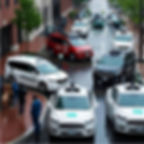Pick-up and Drop-off at the Curb
- May 29
- 8 min read
Updated: Jun 10
Navigating the journey from today's urban congestion and parking challenges to a hybrid future with AVs
May 28, 2025
Most cities see that their transportation infrastructure is already straining under the weight of ride-hailing services, e-commerce deliveries, and evolving urban mobility patterns. URF's examination of safety concerns, accessibility requirements, and scalability challenges highlights the inadequacy of today’s reactive, human-dependent parking and curbside management approaches to addressing pick-up and drop-off activities.
Bern Grush, Executive Director of the Urban Robotics Foundation, points out, "These foundational insights illuminate a stark reality: if current PUDO solutions struggle to address existing mobility demands, they will be utterly overwhelmed by the expected scale of automated vehicle fleets."
This blog post summarizing the discussion from our May 21st webinar: "Managing Pick-up and Drop-off at the Curb". To view the webinar recording on the URF YouTube channel, please click this link: https://www.youtube.com/watch?v=sNJkIep__vM)

The transition from human-driven to robotic vehicles represents more than a technological upgrade—it demands a fundamental reimagining of how cities coordinate the movement of people and goods at their most contested resource: curb space. This transformation requires understanding not just the operational mechanics of automated vehicles, but the deeper principles that govern all vehicle movement and the orchestration systems that will make large-scale robotic transportation possible.
PUDO: The Fundamental Nature of Vehicle Trips
Every trip has two endpoints. With few exceptions—such as biking for pleasure or exercise, automotive pleasure trips like joy riding or racing, and service operations including street sweeping or snow plowing—every vehicle trip serves a single purpose: moving something or someone from one place to another. This principle applies even to motor vehicle trips where the driver is the only passenger.
For the vast majority of vehicle trips, the journey itself is merely a necessary inconvenience between two meaningful endpoints. After 125 years of marketing, when we consider purchasing vehicles, we focus more on the experiential aspects of riding or driving rather than their fundamental purpose as transportation tools.
This is obvious when using ride-hail services, receiving e-commerce deliveries, or having meals delivered by gig drivers. The principle is less apparent when using a personal vehicle as a single occupant, but it remains the same: your pickup point is where you last parked, and your drop-off point is where you next park. This dynamic will transform dramatically for those that transition toward the use of robotic taxis and delivery systems.
Understanding the PUDO Challenge
The PUDO problem fundamentally stems from often having too few pickup and drop-off spots available when and where vehicles need them. This shortage creates a cascade of urban transportation issues: spatial conflicts, congestion, delays, double parking, vehicles circling to find spots, increased enforcement costs, growing curb space demands, operational inefficiencies, higher emissions, and public complaints. These problems are already common at the urban curb and will worsen exponentially as PUDO demand continues to grow.
Urban curbside space has emerged as one of the most contested resources in modern cities. Research by Girón-Valderrama and colleagues documents that without adequate loading zone supply, commercial vehicle drivers are forced to spend more time searching for parking or resort to unauthorized spaces, reducing roadway capacity and creating safety issues. Their observations revealed unauthorized behaviors including double parking and commercial vehicles occupying passenger load zones, with a quarter of unauthorized commercial vehicle behavior involving parking in passenger zones.
The Context: Growing Transportation Complexity
Over the past two centuries, human transportation has evolved from walking and animal power to increasingly sophisticated mechanical and powered vehicles. Recent decades have brought rapid growth in vehicle types and capabilities, creating system complexity that already challenges urban traffic management—including multiple speed lanes, increasingly intricate intersections, parking systems with complex rules and enforcement, human accessibility requirements, cycling infrastructure, the rapid expansion of e-commerce, and the recent introduction of robotic delivery and taxi services.
Rather than the decade-old prediction that “everyone will use robotaxis,” the more likely reality is that transportation modes and machines will continue to diversify and multiply, intensifying the complex competition for PUDO space. The PUDO challenge represents a complex interplay of spatial, temporal, stakeholder, and scale dimensions:
Spatial constraints are defined by limited curb space in dense urban areas. The typical central business district block face offers approximately 60-80 meters of curb space, much of which is already allocated to competing uses. A 2018 International Transport Forum study found that in major cities like Paris, London, and New York, over 80% of curb space was allocated to private vehicle storage despite this representing one of the least efficient uses of this valuable resource.
Temporal dynamics add complexity as PUDO activity follows distinct patterns varying by location, time of day, day of week, and season. Dwell time—how long a vehicle occupies a curb space—critically determines how many vehicles can use that space daily.
Stakeholder complexity emerges from the diverse ecosystem of participants, each with distinct objectives, constraints, and operational models. Passenger transport operators, goods delivery services, property owners, municipal authorities, and the general public all have different requirements and interests in PUDO management.
Scale problems will emerge as automated vehicles enter urban environments in large numbers, with computational and coordination challenges exceeding current approaches and daily PUDO activities potentially numbering in hundreds of thousands across an urban region.
This existing complexity provides essential context for understanding why automated vehicles will amplify rather than simplify urban transportation challenges.
Key Facts Shaping the Automated Future
The Reality of Robotic Vehicle Operations
Robotic taxis and logistics vehicles exist to pick up and drop off people and goods, with many or most of these point activities occurring at urban curbs. The gradual removal of human drivers will eliminate the flexibility, judgment, and improvisation that currently helps navigate ambiguous or contested curbside situations. A human driver can make eye contact with other drivers, negotiate access through gestures, or make real-time decisions about alternative stopping locations. Automated vehicles require explicit instructions, algorithms, or permissions, making the precision of PUDO management far more critical. What will our curbs be like when five percent, 15%, or 50% of PUDO involves driverless vehicles?
Shared Infrastructure and Economic Pressures
Opportunities to create separate lanes and dedicated spaces for robotic vehicles are extremely limited. For the foreseeable future—likely decades—robotic transportation vehicles will share the same contested curb space with conventional vehicles, unpowered vehicles, and pedestrians.
The economic models of automated fleets will intensify these pressures. With lower labor costs, automated service vehicles, especially robotaxis, can operate nearly continuously, each potentially generating many more PUDO events than conventional vehicles. Industry projections suggest that major urban areas will see thousands of automated vehicles in operation by 2030, with each generating approximately 50 daily PUDO events. A modest fleet of 1,200 robotaxis in a city of 120,000 inhabitants implies 2.2 million PUDO events in its host city per year.
The Necessity of Orchestration
Given this complexity and scale, operating large fleets of automatic transportation vehicles requires systematic orchestration of dispatch and PUDO operations. This principle is well-established in industrial settings, where thousands of mobile robots in factories, warehouses, and farms operate under orchestration control. Such systems may be well adapted to those structured environments, but urban curb space is neither highly structured nor able to be dedicated to robotic use.
Without PUDO coordination, we would need multiple, disparate fleets of robotic vehicles to become sufficiently collaborative and knowledgeable about human mobility patterns to self-organize for non-conflicting pickup and drop-off operations. Currently, no viable methods exist for disparate robotic fleets to self-resolve these coordination challenges, making multi-agent fleet orchestration essential for the foreseeable future.
This challenge intensifies because automated fleets will be operated by competing companies with no intrinsic motivation to coordinate their activities. Just as Uber does not share its pick-up plans with Lyft, and FedEx does not coordinate its deliveries with UPS, each automated fleet operator will independently optimize its operations without regard for system-wide efficiency unless required to participate in an orchestration framework.
The Advantage of Programmable Behavior
Unlike human-driven vehicles, robotic vehicles operate according to their software and fleet dispatcher directives. This characteristic creates unprecedented opportunities to coordinate the pickup and drop-off of goods and people in ways never before conceivable with human-driven ground-vehicle systems.
The PUDO challenge bears striking similarities to air traffic control. When multiple aircraft approach an airport simultaneously, they do not negotiate landing order among themselves. Instead, they rely on a central coordination system that optimizes for safety, efficiency, and fairness. Similarly, automated vehicles approaching limited PUDO spaces require systematic orchestration to prevent conflicts, minimize waiting and circling, reduce congestion, and maximize utilization of scarce resources.
Just as air traffic control coordinates thousands of flights using standardized protocols and coordinated timing windows, a PUDO orchestration system manages the digital ‘PUDO plans’ of ground vehicles needing curb access. This recognition has led to the development of draft international standard ISO 25614, establishing a framework for digital PUDO orchestration that defines message formats and transaction flows to enable coordinated access to curb space without requiring competing robo-vehicle operators to expose proprietary information.
Current Management Limitations and the Path Forward
Cities currently attempt to address growing PUDO challenges through various interventions: physical infrastructure solutions including designated rideshare pickup zones and flexible curb uses, regulatory approaches encompassing permitting systems and fee structures, and platform-managed solutions such as geofenced pickup points.
These approaches have provided incremental improvements while falling short of addressing large-scale coordination problems. Current solutions tend to be reactive rather than proactive, focused on individual rather than comprehensive modes, and lacking technical infrastructure for real-time orchestration at scale.
To survive the coming robotaxi revolution, municipal PUDO management must evolve dramatically. Cities need to implement digital orchestration systems that can allocate curb space dynamically based on real-time demand and develop regulations requiring automated vehicle operators to participate in city-wide PUDO coordination. This transformation requires preparing curbs that accommodate specific automated vehicle needs while ensuring accessibility, creating flexible governance models balancing competing stakeholder interests, and investing in digital infrastructure capable of handling millions of PUDO events.
The current approach to PUDO management—with its reliance on static allocations, limited enforcement capacity, and siloed operations—cannot serve robotaxis at scale. Only by embracing comprehensive digital orchestration can cities transform this challenge into an opportunity to create more efficient, equitable, and sustainable urban transportation systems.
Just as we would not deploy thousands of aircraft without air traffic control, we cannot realize the full potential of automated vehicles without solving the fundamental coordination problem they present at scale. The transition to automated mobility makes managing curb access paramount to prevent congestion, maximize safety, maintain service efficacy and equity, reduce enforcement expense, and enable equitable monetization as a management mechanism.
What began as a contest for limited curb space is now evolving into a complex orchestration challenge that will define the future of urban mobility. Cities that proactively engage balanced PUDO management systems will be positioned to harness the transformative potential of automated vehicles, while those that delay this transition risk being overwhelmed by the very technologies meant to address current transportation challenges.
The fundamental nature of vehicle trips as point-to-point transportation, combined with the programmable behavior of automated vehicles and the necessity of systematic orchestration, creates both the imperative and the opportunity for revolutionary advances in urban transportation management.
The question is not whether this transformation will occur, but whether cities will lead it or be forced to react to it. We invite you to engage with us in shaping the future of urban mobility: https://www.urbanroboticsfoundation.org/member-benefits. Annual membership starts at C$750/year for individual researchers and C$1,500 for small cities and technology companies.


